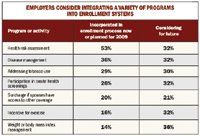Enrollment process offers key opportunities
The enrollment process offers opportunities to engage employees, but the tools themselves are not enough, according to one industry expert.

"The data behind the tool, as well as a well-orchestrated campaign that supports the messages and behaviors is needed for success," says Jeri Stepman, Watson Wyatt's national leader for health and welfare administration.
"It also is important to define success since we realize that not all employees will engage in this process," Stepman adds.
"The enrollment process is a key opportunity to get the attention of your participants," she says. "If the desire is to increase participation in the health-risk assessment, integration with annual enrollment in a way that makes it easy for employees to access the tool and receive the results will foster that result."
Tying risk assessments into the enrollment process helps avoid duplication of reported data fields from the members, resulting in improved accuracy, according to Clive Riddle, president and founder of MCOL, a provider of business-to-business health management and managed care resources in Modesto, Calif.
"The data reported during enrollment will tend to be more accurate than when self-reported for other purposes during other times of the year," Riddle says. "A number of health plans are now capturing health-risk-assessment data for predictive modeling purposes, to identify specific candidates for care management among other objectives.
"By incorporating health-risk assessments into the enrollment process, additional demographic data is available from the same data source, with a greater degree of accuracy, all of which improves the predictive modeling process as well," he adds.
Incorporating incentives for participation in risk assessments that relate to enrollment options can further enhance and leverage a risk-assessment enrollment process strategy, according to Riddle. "Perhaps the strongest motivator is a premium-contribution reduction for participation, which directly ties into the enrollment process," he says.
The Department of Labor has recently issued a checklist and guidelines for how to development such wellness incentive programs that are compliant from a regulatory perspective.
"A challenge with tying any program to the enrollment process is that unfortunately the standard in the employer marketplace is still to allow retroactive enrollments and disenrollments, and these transactions need to be taken into consideration when administering risk assessments," Riddle says.
Stepman offers this final thought: "Implement an enrollment process that allows for targeted messaging, seamless integration of tools and process and the flexibility to roll-in new features and functions. Annual enrollment is a communication opportunity that should not be missed."
Breaking Down Health Plans, HSAs, AI With Paul Fronstin of EBRI
November 19th 2024Featured in this latest episode of Tuning In to the C-Suite podcast is Paul Fronstin, director of health benefits research at EBRI, who shed light on the evolving landscape of health benefits with editors of Managed Healthcare Executive.
Listen
In this latest episode of Tuning In to the C-Suite podcast, Briana Contreras, an editor with MHE had the pleasure of meeting Loren McCaghy, director of consulting, health and consumer engagement and product insight at Accenture, to discuss the organization's latest report on U.S. consumers switching healthcare providers and insurance payers.
Listen
Prime Therapeutics Finds No Medical Cost Offsets for GLP-1 Obesity Drugs | AMCP Annual 2025
April 1st 2025A Prime Therapeutics analysis of real-world data has found that medical costs for patients taking GLP-1 drugs for obesity had increased by about $1,338 per member, compared with a matched control group.
Read More